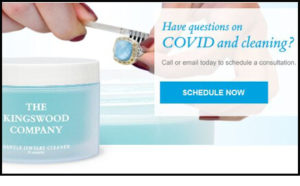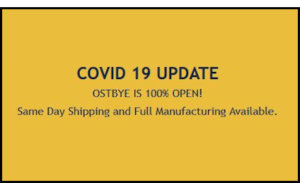Managing The Message
More than ever, it’s important to communicate transparency and compassion.
At a time when everyone is to “expect the unexpected”, brands that can navigate COVID-19 — by implementing the right messaging, adding value to customers, analyzing what’s working and what’s not, and being nimble to change — have the greatest opportunity to come out of this stronger.
 This is the message ShipBob, a tech-enabled fulfillment service shares in a webinar series showcasing a variety of its ecommerce customers sharing valuable ideas and insights that jewelers can apply to their businesses.
This is the message ShipBob, a tech-enabled fulfillment service shares in a webinar series showcasing a variety of its ecommerce customers sharing valuable ideas and insights that jewelers can apply to their businesses.
Make your COVID response prominent. Add a banner to the top of your ecommerce website with your response to COVID-19. At the bare minimum, it should acknowledge COVID-19 and you’re shipping status. In tandem with a website banner, get the message out via email, blog and other media posts regarding your store’s COVID response, including precautions taken to ensure safety in your operation.
“You need to go out of your way to message about COVID-19; people are looking for that now,” shared Dana Varrone, director of operations for Organic Olivia, a wellness lifestyle platform. “Customers want to feel safe and in control. Being able to connect with them has helped keep our customers purchasing.” She noted that company founder Olivia Amitrano openly shares with customers about her parents who have COVI-19. “This authenticity is appreciated.”
It’s important to communicate transparency and compassion. Be sensitive to the fact that customers may have lost their jobs or be impacted by the virus in a personal way. Jewelers of America offers a sample letter to customers that jewelers can use to describe the steps and procedures they’re implementing to keep employees and customers safe, and stores clean when open.
Recognize lifestyle changes in your messaging, said Leo Carrillo, CEO and co-founder of Hair Craft Co., men’s hair care products. As an example, he spoke about Lululemon, apparel and gear brand for sports and travel, which used to push their “men’s commuter comfortable” line for people on planes every other week for meetings and conferences. Now that no one is flying, the brand is including more content related to “home workouts” and “work from home”.
It’s challenging to be as human as possible in your messaging, while juggling the marketing and selling needed to stay in business. Jon Corwin, director of growth marketing at One Click Venture noted that Readers, a non-prescription reading glasses and sunglasses company, as walking the line successfully. The brand is sharing helpful, interesting advice relating their product to the impact of the coronavirus and stay-at-home orders, as more people are reading in general and spending more time on their devices. Among its blog topics: How to Keep Your Eyes Healthy at Home How to Safely Sanitize Your Glasses, 5 Ways to Look and Feel Your Best While Working from Home, and Coronavirus: How Our Eyes May Impact Its Spread.
stay in business. Jon Corwin, director of growth marketing at One Click Venture noted that Readers, a non-prescription reading glasses and sunglasses company, as walking the line successfully. The brand is sharing helpful, interesting advice relating their product to the impact of the coronavirus and stay-at-home orders, as more people are reading in general and spending more time on their devices. Among its blog topics: How to Keep Your Eyes Healthy at Home How to Safely Sanitize Your Glasses, 5 Ways to Look and Feel Your Best While Working from Home, and Coronavirus: How Our Eyes May Impact Its Spread.
Carrillo advised businesses to develop content from an SEO perspective. “Discover what people are searching for as they have more time for education.”
Along those lines, jewelers can be sharing information about jewelry care and cleaning during COVID times. The Kingswood Company, Columbus, Ohio-based manufacturer of custom brand jewelry cleaning and care products, offers its customers information, content and other resources to tap into this narrative.
Tracking week-over-week and month-over-month sales of more than 3,000 of its ecommerce merchants, ShipBob cited categories like baby and beauty products, sports and fitness equipment, and food and beverage up. But reported jewelry down, reasoning that “in a transformed world full of Zoom meetings filled with people in their sweats, rarely leaving the house, few consumers are wearing jewelry these days — and the ecommerce sales data shows it.”
 Jewelers can take the lead as stylists for our new Zoom world. For inspiration, the fashion blog popsugar.com highlighted what it considers “The Best Accessories Made For All Those Zoom Calls”. Among them, hoop and stud earrings, layered necklaces, and bejeweled hair accessories. “Accessories can go a long way in helping you look put together, even if you’re only seen from the chest up,” the blog mused. The magazine GQ, in a recent article advised men how to “Ace Zoom Casual”, calling for a bit of flash like a slim chain necklace.
Jewelers can take the lead as stylists for our new Zoom world. For inspiration, the fashion blog popsugar.com highlighted what it considers “The Best Accessories Made For All Those Zoom Calls”. Among them, hoop and stud earrings, layered necklaces, and bejeweled hair accessories. “Accessories can go a long way in helping you look put together, even if you’re only seen from the chest up,” the blog mused. The magazine GQ, in a recent article advised men how to “Ace Zoom Casual”, calling for a bit of flash like a slim chain necklace.
Tap into COVID-19 sales trends. Patrick Coddou, founder and CEO of Supply, a direct-to-consumer company specializing in single-blade razors for men and other grooming products, capitalized on consumer trends to hoard/stock-up. He mentioned that Supply rarely discounts, as they sell more of a luxury product. But then sales “went off a cliff”. “I knew the day would come when our price point would be a hard sell in this environment.” The company turned that around by offering a year’s worth of blades free with razor purchase, tailoring their strategy to what people want in this moment.
Times are changing and everyone has to pivot. “If return on investment for ads isn’t there and ecommerce COVID-19 conversions are dropping, you need to find more scrappy methods to make up any revenue gap you’ve seen,” advocated Carrillo, citing things like up-selling and cross-selling different products, deals to share with friends, BOGO or gift with purchase (an ideal opportunity to promote jewelry cleaning and care products).
Carrillo also sees an opportunity for local small businesses to capture customers by promoting quicker/alternative delivery options, as people are experiencing fulfillment delays up to 30 days on Amazon.
The core message is how can you help — with inspiration, ideas, information, value, and convenience.